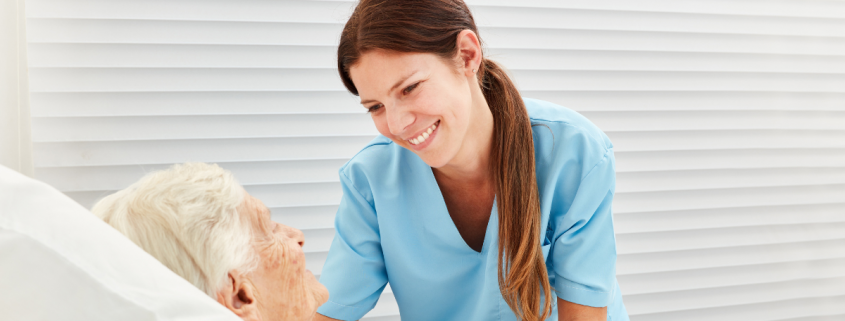Maintaining Skin Health: Preventing Bedsores in Bedridden Patients
Bedsores are a common challenge experienced by bedridden individuals. They are also known as decubitus ulcers or pressure ulcers and significantly affect the quality of life of the patients. In this post, we will delve deeper into preventing and treating these skin lesions. But first, what do bed sores look like, and what causes them?
In the simplest explanation, bedsores refer to localised lesions on the skin and the underlying tissues. Although they can affect any body part, these injuries often occur over bony prominences, including heels, elbows, hips and lower back. But what causes pressure ulcers?
READ MORE: What do bed sores look like?
- Prolonged pressure on the skin – This impairs proper blood circulation to the skin, which makes it more susceptible to damage and injuries.
- Friction – If the skin constantly rubs against the bedding or clothing, it could lose its protective barrier, which increases the risk of decubitus ulcers.
- Excessive moisture – This softens the skin’s outer layer, which makes it easier to shed the outer layer and the slightest rubbing and friction.
- Limited mobility – This affects many bedridden individuals as they may not be able to change positions independently, which puts pressure on a specific body part for long
Bedsores can be extremely painful and have a significant impact on the quality of life for bedridden individuals. That is why it is essential to implement effective skincare routines.
Importance of Skincare for Bedridden Individuals
Maintaining an effective skincare routine is essential to preventing different stages of pressure ulcers in bedridden individuals. It ensures their comfort, well-being and improved quality of life. Unfortunately, it can be relatively difficult for bedridden individuals to implement a skincare routine by themselves – and that’s where caregivers come in.
The Role of Caregivers in Maintaining Skin Health for Bedridden Individuals
Besides providing emotional support, caregivers play a pivotal role in preventing and treating different stages of pressure ulcers. Here is an effective skincare regimen used by professional caregivers:
- Daily inspection – Regular inspection helps caregivers identify the early signs of irritation that precede the development of pressure ulcers. Keeping an eye out for these early signs enables these care providers to promptly treat skin issues before they escalate to full-blown decubitus ulcers.
- Cleansing – As they spend most of their time in bed, bedridden individuals are highly susceptible to the build-up of sweat and other bodily fluids that can build up on the skin. These impurities create an environment conducive to skin breakdown. That’s why caregivers should use the right cleansers to remove the impurities from the skin.
- Moisturising – Moisturising the skin helps prevent skin dryness, a common factor that contributes to fragile skin. Caregivers should apply moisturises after cleansing – a moisturiser for sensitive skin is highly recommended.
- Preventing irritants – Irritants can significantly increase the risk of pressure sores formation. For that reason, caregivers should check to ensure they minimise the number of irritants bedridden individuals come across. That involves using soft, breathable fabrics for clothing and bedding to minimise the risk of friction.
How to Treat Bedsores in Bedridden Individuals
Although proper skin care can help reduce the risk, bedridden individuals can still get decubitus ulcers. Prompt and proper pressure sores treatment is key to preventing further infection, promoting healing and alleviating discomfort. Here is a guide for treating pressure sores in bedridden individuals:
- Cleaning the wounds – When pressure sores develop, it is essential to keep the wounds clean to avoid further infection. Caregivers should use a doctor-recommended wound cleanser to clean the area gently. Do not use harsh soaps and antiseptics, as these can irritate the wound further.
- Applying dressings – Once the wound is clean and patted dry, apply a dressing to provide a protective barrier to prevent further contamination. Ask a medical professional to recommend a suitable type of dressing based on the stage of the pressure ulcers.
- Seeking medical attention – While caregivers can easily manage minor pressure ulcers with proper wound care, it is wise to involve a medical professional in the treatment process, especially for severe cases. A medical expert will accurately assess the wounds and determine the best approach to treatment.
While it can be tempting to attempt self-treatment of these pressure sores, it is essential to rely on the help of a medical professional. Pressure ulcers vary in severity, and if they are not appropriately treated, they can escalate to complications such as sepsis and cellulitis. Consulting a medical expert in pressure sores treatment increases the chances of successful wound healing as they have the expertise to accurately diagnose the stage of infection and recommend a tailored treatment.
How to Prevent Bedsores in Bedridden Patients
Keeping away these painful lesions requires a proactive and comprehensive approach. Caregivers should implement practical strategies to reduce the risk of these pressure ulcers. Here are a few tips for preventing these pressure ulcers:
- Maintain cleanliness – Clean the skin regularly with gentle cleansers to remove dirt, bacteria and sweat that increase the risk of skin breakdowns. Invest more attention to areas with a higher risk of developing pressure ulcers, including lower back and heels.
- Use proper lifting technique – When repositioning the bedridden patient, consider lifting rather than sliding to avoid friction that could increase the risk of pressure sores.
- Avoid excessive moisture – As mentioned earlier, too much moisture on the skin can weaken it – consider keeping the bedding and clothing dry to minimise the risk of dampness. Use highly absorbent fabrics for clothing and bedding.
- Provide fresh clothing and bedding regularly – Using fresh beddings and clothing keeps dirt away from the skin, which minimises the risk of pressure sores. Besides keeping them clean, ensure the fabrics are soft and breathable to reduce friction.
Conclusion
Maintaining healthy skin through proper hygiene is not only crucial for maintaining physical comfort but also for ensuring holistic well-being. Our skin acts as a protective barrier that keeps harmful germs from entering our body, and that’s why healthy skin is essential for our overall well-being. For bedridden individuals, maintaining healthy skin is vital to their well-being as it reduces the risk of bedsores. Contact Veritas Care today for a complete care assessment for bedridden patients.















